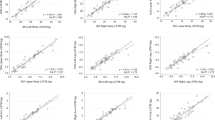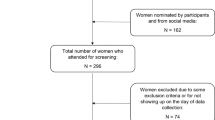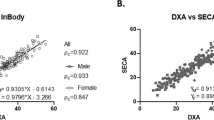Abstract
Background/Objectives: (1) To cross-validate tetra- (4-BIA) and octopolar (8-BIA) bioelectrical impedance analysis vs dual-energy X-ray absorptiometry (DXA) for the assessment of total and appendicular body composition and (2) to evaluate the accuracy of external 4-BIA algorithms for the prediction of total body composition, in a representative sample of Swiss children.
Subjects/Methods: A representative sample of 333 Swiss children aged 6–13 years from the Kinder-Sportstudie (KISS) (ISRCTN15360785). Whole-body fat-free mass (FFM) and appendicular lean tissue mass were measured with DXA. Body resistance (R) was measured at 50 kHz with 4-BIA and segmental body resistance at 5, 50, 250 and 500 kHz with 8-BIA. The resistance index (RI) was calculated as height2/R. Selection of predictors (gender, age, weight, RI4 and RI8) for BIA algorithms was performed using bootstrapped stepwise linear regression on 1000 samples. We calculated 95% confidence intervals (CI) of regression coefficients and measures of model fit using bootstrap analysis. Limits of agreement were used as measures of interchangeability of BIA with DXA.
Results: 8-BIA was more accurate than 4-BIA for the assessment of FFM (root mean square error (RMSE)=0.90 (95% CI 0.82–0.98) vs 1.12 kg (1.01–1.24); limits of agreement 1.80 to -1.80 kg vs 2.24 to -2.24 kg). 8-BIA also gave accurate estimates of appendicular body composition, with RMSE ⩽0.10 kg for arms and ⩽0.24 kg for legs. All external 4-BIA algorithms performed poorly with substantial negative proportional bias (r⩾0.48, P<0.001).
Conclusions: In a representative sample of young Swiss children (1) 8-BIA was superior to 4-BIA for the prediction of FFM, (2) external 4-BIA algorithms gave biased predictions of FFM and (3) 8-BIA was an accurate predictor of segmental body composition.
This is a preview of subscription content, access via your institution
Access options
Subscribe to this journal
Receive 12 print issues and online access
$259.00 per year
only $21.58 per issue
Buy this article
- Purchase on Springer Link
- Instant access to full article PDF
Prices may be subject to local taxes which are calculated during checkout


Similar content being viewed by others
References
Bedogni G, Iughetti L, Ferrari M, Malavolti M, Poli M, Bernasconi S et al. (2003a). Sensitivity and specificity of body mass index and skinfold thicknesses in detecting excess adiposity in children aged 8–12 years. Ann Hum Biol 30, 132–139.
Bedogni G, Malavolti M, Severi S, Poli M, Mussi C, Fantuzzi AL et al. (2002). Accuracy of an eight-point tactile-electrode impedance method in the assessment of total body water. Eur J Clin Nutr 56, 1143–1148.
Bedogni G, Marra M, Bianchi L, Malavolti M, Nicolai E, De Filippo E et al. (2003b). Comparison of bioelectrical impedance analysis and dual-energy X-ray absorptiometry for the assessment of appendicular body composition in anorexic women. Eur J Clin Nutr 57, 1068–1072.
Bertoli S, Battezzati A, Testolin G, Bedogni G (2007). Evaluation of air-displacement plethysmography and bioelectrical impedance analysis vs dual-energy X-ray absorptiometry for the assessment of fat-free mass in elderly subjects. Eur J Clin Nutr; e-pub ahead of print 25 July 2007.
Chomtho S, Fewtrell MS, Jaffe A, Williams JE, Wells JC (2006). Evaluation of arm anthropometry for assessing pediatric body composition: evidence from healthy and sick children. Pediatr Res 59, 860–865.
Chumlea WC, Schubert CM, Sun SS, Demerath E, Towne B, Siervogel RM (2007). A review of body water status and the effects of age and body fatness in children and adults. J Nutr Health Aging 11, 111–118.
de Lorenzo A, Sorge SP, Iacopino L, Andreoli A, de Luca PP, Sasso GF (1998). Fat-free mass by bioelectrical impedance vs dual-energy X-ray absorptiometry (DXA). Appl Radiat Isot 49, 739–741.
Deurenberg P, Smit HE, Kusters CS (1989). Is the bioelectrical impedance method suitable for epidemiological field studies? Eur J Clin Nutr 43, 647–654.
Efron B, Tibshirani R (1993). An Introduction to the Bootstrap. Chapman & Hall: New York.
Fuller NJ, Elia M (1989). Potential use of bioelectrical impedance of the ‘whole body’ and of body segments for the assessment of body composition: comparison with densitometry and anthropometry. Eur J Clin Nutr 43, 779–791.
Fuller NJ, Fewtrell MS, Dewit O, Elia M, Wells JC (2002). Segmental bioelectrical impedance analysis in children aged 8–12 y: 2. The assessment of regional body composition and muscle mass. Int J Obes Relat Metab Disord 26, 692–700.
Gallagher D, Visser M, De Meersman RE, Sepúlveda D, Baumgartner RN, Pierson RN et al. (1997). Appendicular skeletal muscle mass: effects of age, gender, and ethnicity. J Appl Physiol 83, 229–239.
Guo SS, Chumlea WC, Cockram DB (1996). Use of statistical methods to estimate body composition. Am J Clin Nutr 64, 428S–435S.
Harrell FE (2001). Regression Modeling Strategies: With Applications to Linear Models, Logistic Regression, and Survival Analysis. Springer: New York.
Kim J, Shen W, Gallagher D, Jones A, Wang Z, Wang J et al. (2006). Total-body skeletal muscle mass: estimation by dual-energy X-ray absorptiometry in children and adolescents. Am J Clin Nutr 84, 1014–1020.
Kuczmarski RJ, Ogden CL, Grummer-Strawn LM, Flegal KM, Guo SS, Wei R et al. (2000). CDC growth charts: United States. Adv Data 8, 1–27.
Kushner RF (1992). Bioelectrical impedance analysis: a review of principles and applications. J Am Coll Nutr 11, 199–209.
Kushner RF, Gudivaka R, Schoeller DA (1996). Clinical characteristics influencing bioelectrical impedance analysis measurements. Am J Clin Nutr 64 (3 Suppl), 423S–427S.
Lohman TG, Going SB (2006). Body composition assessment for development of an international growth standard for preadolescent and adolescent children. Food Nutr Bull 27, S314–S325.
Lohman TG, Roche AF, Martorell R (1988). Anthropometric Standardization Reference Manual. Human Kinetics Books: Champaign, IL.
Ludbrook J (2002). Statistical techniques for comparing measurers and methods of measurement: a critical review. Clin Exp Pharmacol Physiol 29, 527–536.
Malavolti M, Mussi C, Poli M, Fantuzzi AL, Salvioli G, Battistini N et al. (2003). Cross-calibration of eight-polar bioelectrical impedance analysis versus dual-energy X-ray absorptiometry for the assessment of total and appendicular body composition in healthy subjects aged 21–82 years. Ann Hum Biol 30, 380–391.
Maynard LM, Wisemandle W, Roche AF, Chumlea WC, Guo SS, Siervogel RM (2001). Childhood body composition in relation to body mass index. Pediatrics 107, 344–350.
Medici G, Mussi C, Fantuzzi AL, Malavolti M, Albertazzi A, Bedogni G (2005). Accuracy of eight-polar bioelectrical impedance analysis for the assessment of total and appendicular body composition in peritoneal dialysis patients. Eur J Clin Nutr 59, 932–937.
Nielsen BM, Dencker M, Ward L, Linden C, Thorsson O, Karlsson MK et al. (2007). Prediction of fat-free body mass from bioelectrical impedance among 9- to 11-year-old Swedish children. Diabetes Obes Metab 9, 521–539.
NIH (1996). Bioelectrical impedance analysis in body composition measurement: National Institutes of Health Technology Assessment Conference Statement. Am J Clin Nutr 64, 524S–532S.
Pietrobelli A (2004). Outcome measurements in paediatric obesity prevention trials. Int J Obes Relat Metab Disord 28 (Suppl 3), S86–S89.
Pietrobelli A, Andreoli A, Cervelli V, Carbonelli MG, Peroni DG, De Lorenzo A (2003). Predicting fat-free mass in children using bioimpedance analysis. Acta Diabetol 40 (Suppl 1), S212–S215.
Pietrobelli A, Formica C, Wang Z, Heymsfield SB (1996). Dual-energy X-ray absorptiometry body composition model: review of physical concepts. Am J Physiol 271, E941–E951.
Pietrobelli A, Rubiano F, St-Onge MP, Heymsfield SB (2004). New bioimpedance analysis system: improved phenotyping with whole-body analysis. Eur J Clin Nutr 58, 1479–1484.
Plank LD (2005). Dual-energy X-ray absorptiometry and body composition. Curr Opin Clin Nutr Metab Care 8, 305–309.
Sartorio A, Malavolti M, Agosti F, Marinone PG, Caiti O, Battistini N et al. (2005). Body water distribution in severe obesity and its assessment from eight-polar bioelectrical impedance analysis. Eur J Clin Nutr 59, 155–160.
Tanner JM (1962). Growth at adolescence 2nd edn. Blackwell Scientific Publications: Oxford, England.
Wang ZM, Visser M, Ma R, Baumgartner RN, Kotler D, Gallagher D et al. (1996). Skeletal muscle mass: evaluation of neutron activation and dual-energy X-ray absorptiometry methods. J Appl Physiol 80, 824–831.
Wells JC (2003). Body composition in childhood: effects of normal growth and disease. Proc Nutr Soc 62, 521–528.
Wells JC, Fewtrell MS (2006). Measuring body composition. Arch Dis Child 91, 612–617.
Zahner L, Puder JJ, Roth R, Schmid M, Guldimann R, Pühse U et al. (2006). A school-based physical activity program to improve health and fitness in children aged 6–13 years (‘Kinder-Sportstudie KISS’): study design of a randomized controlled trial [ISRCTN15360785]. BMC Public Health 6, 147.
Acknowledgements
KISS is supported by research grants from the Swiss Federal Office of Sports and the Swiss National Foundation.
Author information
Authors and Affiliations
Corresponding author
Additional information
Guarantors: S Kriemler and G Bedogni.
Contributors: SK and LZ coordinated the study and contributed to the final version of the manuscript; JP and RR were main investigators of the study and contributed to the final version of the manuscript; CB-F supervised the study and gave important inputs for the content of the manuscript; GB performed statistical analysis and wrote the first draft of the article.
Rights and permissions
About this article
Cite this article
Kriemler, S., Puder, J., Zahner, L. et al. Cross-validation of bioelectrical impedance analysis for the assessment of body composition in a representative sample of 6- to 13-year-old children. Eur J Clin Nutr 63, 619–626 (2009). https://doi.org/10.1038/ejcn.2008.19
Received:
Revised:
Accepted:
Published:
Issue Date:
DOI: https://doi.org/10.1038/ejcn.2008.19



